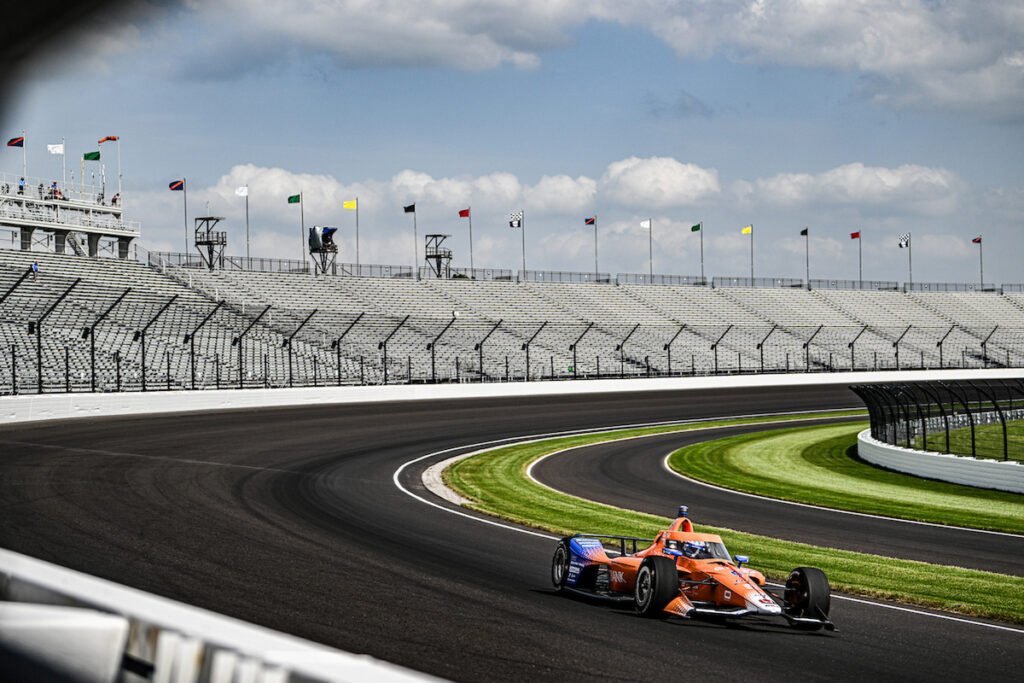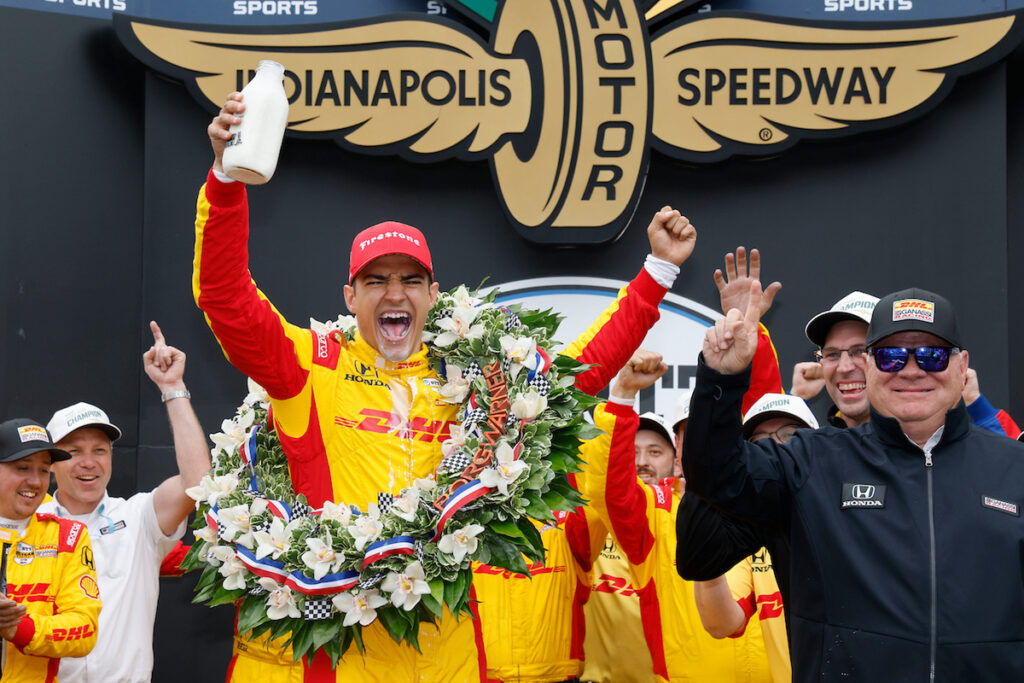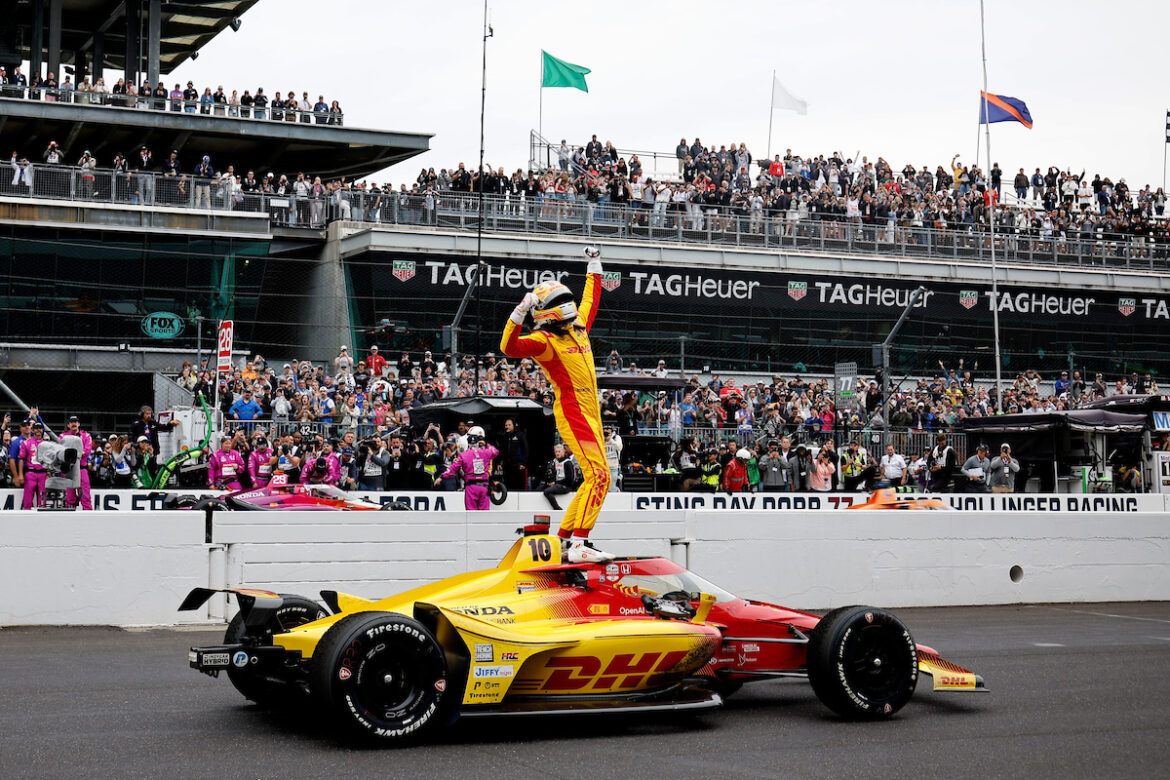Given the inflated sense of importance that many American racing fans place on the Indianapolis 500, a victory on the Indianapolis Motor Speedway oval was the only thing standing between Alex Palou and true greatness. The 28-year-old Spaniard checked that box with with a confident victory for Chip Ganassi Racing in the 109th running of ‘The Greatest Spectacle in Racing.’
Already a three-time champion in the NTT IndyCar Series, Palou’s fifth triumph in six starts this year was by far the most important individual race win of his relatively brief career, coming with nearly $5 million in prize money and a face etched onto the Borg-Warner Trophy.
Palou caught 2022 Indy 500 winner Marcus Ericsson by surprise with a decisive pass for the lead on Lap 187 of 200. With the leaders bottled up behind a pair of backmarkers, a shootout for the win never developed and the point was rendered moot when Nolan Siegel’s crash on the last lap brought out the caution as Palou led Ericsson into the final corner. Perennial Indy frontrunner Pato O’Ward was a disappointed fourth.
It was another crushingly competent performance by Palou, who qualified sixth and ran unobtrusively among the leaders all day before taking command at the end to lead the final 14 laps. It was the only time he was out front all day.
Palou’s day contained little drama other than a close call in the cramped pit lane and a couple scary moments on restarts. Having made his final stop several laps earlier than Ericsson, he laid back in the opening phase of the stint conserving fuel and tires before moving past Malukas. The capacity crowd expected Palou to wait until the very end to try to pass Ericsson for the lead, but the presence of Rahal Letterman Lanigan Racing teammates Louis Foster and Devlin DeFrancesco fighting for 14th place directly in front of them complicated matters.
When Ericsson left an opening into Turn 1 with fourteen laps remaining, Palou didn’t hesitate.
“We were not in the best position on strategy,” explained the Ganassi driver. “We had the worst tires, and less fuel than Marcus and a little less than Malukas. I knew it was going to be tough at the end and I was just not going to have a chance to overtake him. It was a bit too early to go for it, but I thought it was my best strategy to try to go with the traffic and try to get the win. I’m glad I made it work.”
Ericsson was despondent after his second runner-up finish at Indianapolis in the last three years, those coming on the heels of his surprise 2022 victory.

At one point, a slow pit stop dropped him to the tail of the lead lap. But savvy use of yellows and an effective long green-flag stint allowed the Andretti Global team to execute a strategy that gave their driver track position and a 4-6 lap advantage on fuel and tires as the race drew to a close. That’s when the backmarkers trying to stay on the lead lap came into play.
“I had those lapped cars ahead and I was struggling a little bit in the dirty air,” Ericsson recounted. “Alex kind of got a run on me, but I didn’t think he was going to go for it. And that’s the thing that’s going to keep me up at night for a while – that moment and what I did and didn’t do.
“This is a ‘winner takes it all’ kind of race, and I had that race covered,” he quietly added. “It’s pretty painful. It’s going to keep me up at night thinking about what I could have done different in that last stint. Second is a good result, but here, it’s not a good result. Here, you’ve got to win.”
Generally speaking, it was a dull and processional race. This was the first Indianapolis 500 for IndyCar’s new-in-mid-2024 hybrid energy recovery system, and the 132-pound hardware adversely affected the handling of an already-tail-heavy Dallara chassis. The pole speed was down by 1.5 mph, and the small margin for error in unbalanced cars made it extremely difficult to pass, especially for drivers third or further back in a line.
Fuel saving strategies also played a part, as 14 of the 33 drivers led at one stage of the race. Front row starter (and two-time Indy winner) Takuma Sato led the most laps with 51, followed by 2014 winner Ryan Hunter-Reay’s 48. But neither figured in the final reckoning. Sato, trying for a third Indy crown, was 11th at the flag.
The race was delayed by 43 minutes by light rain, and the cold conditions (63 degrees Fahrenheit, or 17 C) likely contributed to a spate of brake problems like the one that led to pole sitter Robert Shwartzman’s ill-fated pit stop and Rinus Veekay’s pit lane crash. The left-rear corner of Scott Dixon’s car caught fire on the warm-up laps, and the New Zealander eventually lost three laps when the Ganassi team changed the left-rear caliper about a quarter of the way into the race. Dixon, the 2008 Indy winner still in search of an elusive second, finished 23rd.

Team Penske’s race day was nearly as bad as its qualifying weekend. Scott McLaughlin crashed on the pace lap while warming his tires. “By far, the worst moment of my life,” stated McLaughlin. “I know it’s probably dramatic and whatever, but I put so much into this race. Everyone does, and I didn’t even get to see the green flag.” Josef Newgarden dropped out with a faulty fuel pump two-thirds of the way into the race, while Power scraped home a lap down in 19th place. Newgarden’s retirement with a duff fuel pump took away the potential unprecedented-three-Indy-wins-in-a row angle; Helio Castroneves’ quest for an equally historic fifth victory was never in the cards, the 50-year-old Brazilian coming home 13th.
NASCAR star Kyle Larson had a 40-minute fudge factor to facilitate his ability to compete in both the Indianapolis 500 and the Cup Series Coca-Cola 600 at Charlotte Motor Speedway later the same day. The 43-minute rain delay could have had a critical impact, but Larson crashed on a Lap 92 restart, eliminating any drama whether he would make it back to his ‘day job’ on time. Another crash put Larson out of contention at Charlotte in what will likely be his last attempt at the Indy/Charlotte ‘Double.’
Malukas wound up tops among the rest in the best finish of 2025 for A.J. Foyt Racing, which now operates as a Penske satellite team. Meanwhile, O’Ward had the opportunity to complete a memorable double for McLaren following Lando Norris’s victory in the Monaco Grand Prix. But the Mexican turned in a strangely subdued performance in the race. Despite starting from the favorable outside of the front row, he never led nor looked like being a factor.
“We’ve seemed to have had every single result in the top five over the past five years except for the most important one,” O’Ward lamented. “Congratulations to Alex; I’ve got to get on whatever he’s eating or sleeping, because he’s on a run like I’ve never seen before, one I don’t think the series has seen in 50 years or more.”

Now boasting an Indianapolis win and presumably on his way to a fourth IndyCar championship (he has a 115-point lead over O’Ward, with a maximum of 53 points available per race weekend), Palou is already in the conversation about all time Indy racing superstars. His Indianapolis victory was the sixth for team owner Chip Ganassi, whose roster of Indy winners includes Ericsson, Scott Dixon, Dario Franchitti, and Juan Pablo Montoya.
Palou has won 16 races in 88 IndyCar starts.
“I’ll tell you, that kid is a good driver,” Ganassi said. “It’s just incredible – he’s on a roll. I think he’s one of the greats – it’s that simple. Certainly we’ve had some great drivers on our team, and he’s right there, at worst, shoulder to shoulder with all the rest of them. You’ve got to talk about all the great champions we’ve had, and he’s clearly in that group now.”


